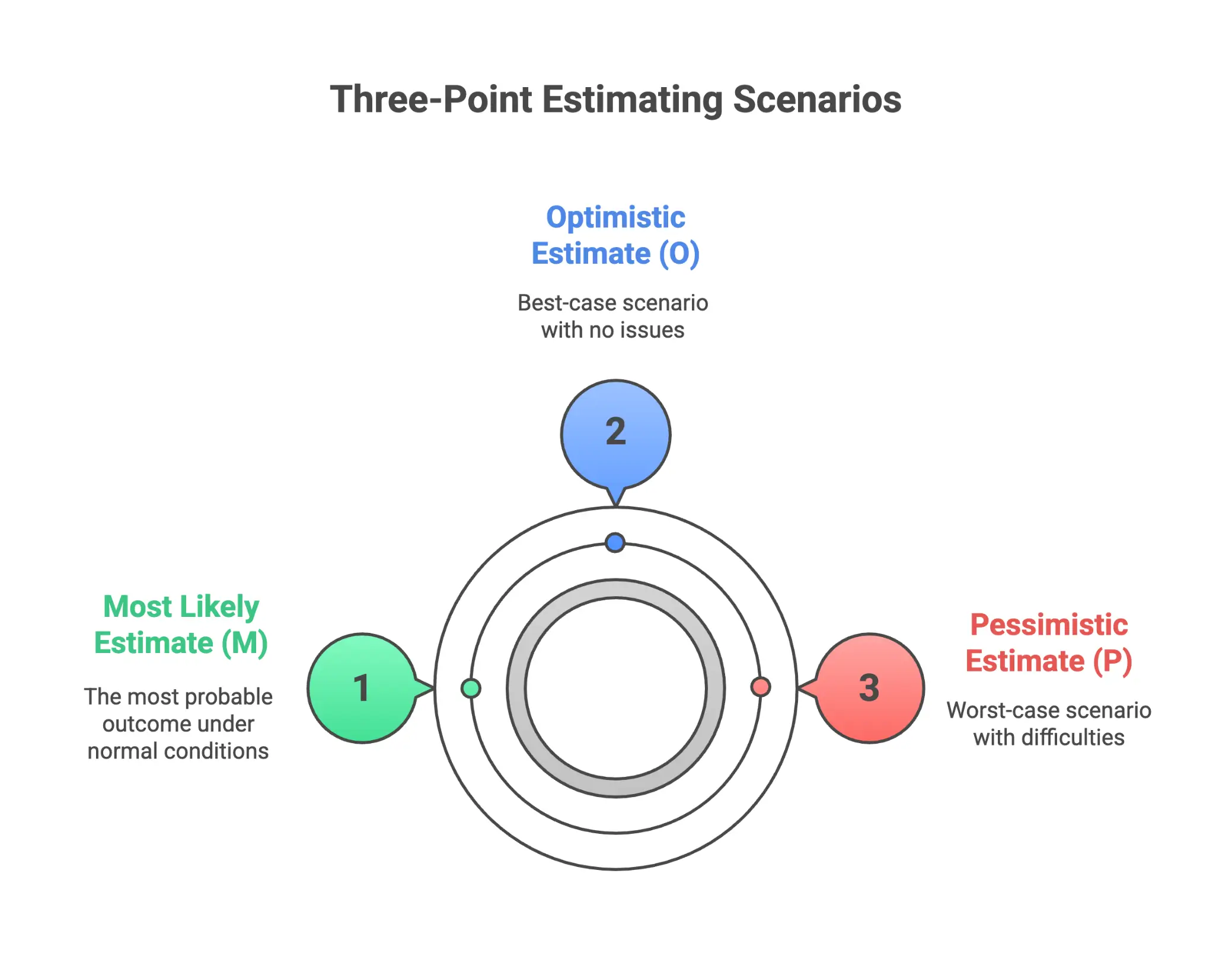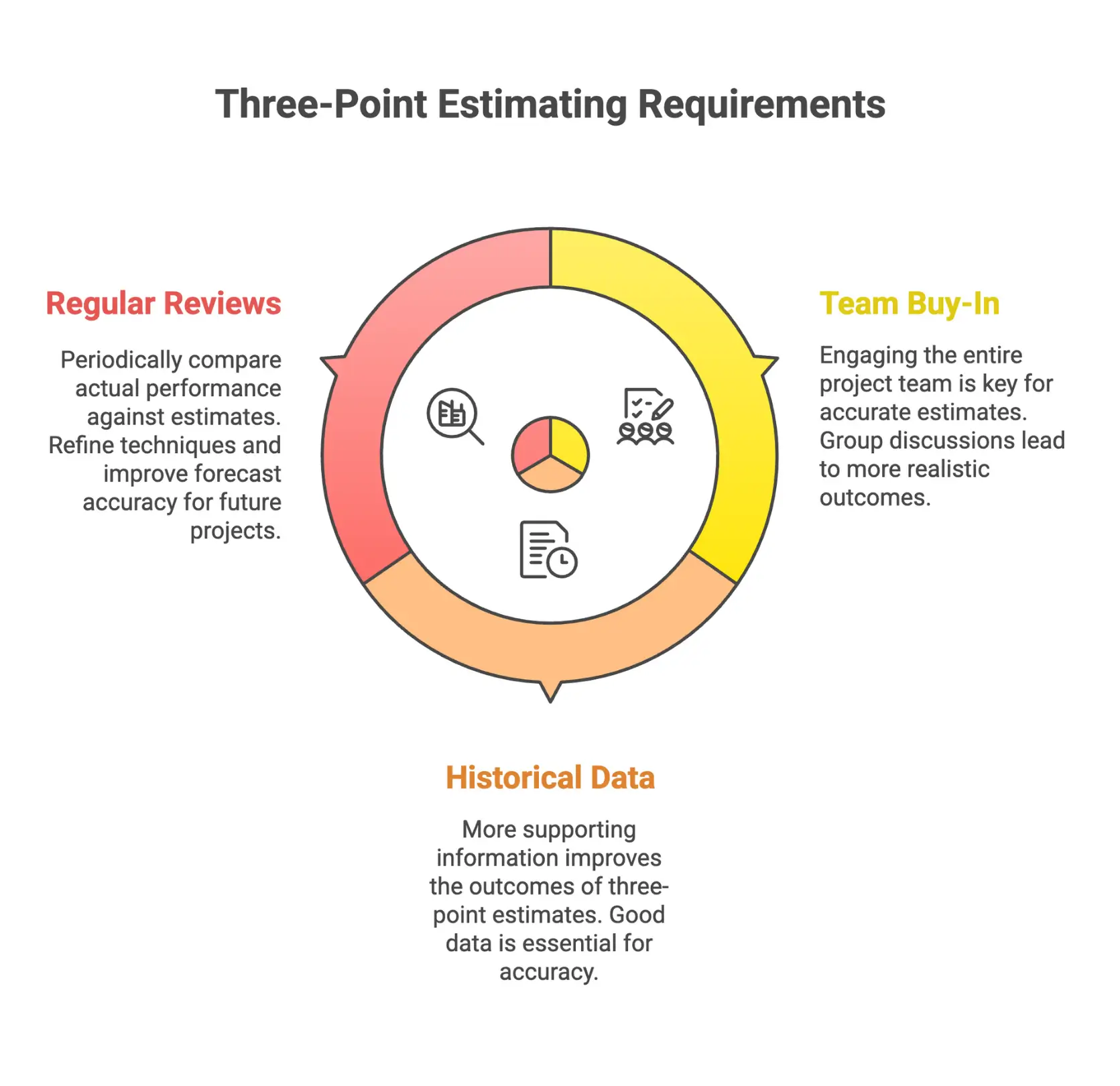

What Is Three-Point Estimating? Accurate Project Forecasting Guide
TL;DR: Three-point estimating is an estimation technique used to develop more accurate forecasts in project management. By evaluating three outcomes for each estimate: optimistic estimate, pessimistic estimate, and most likely estimate, project managers get a range of potential results rather than a single guess. This technique minimizes bias, strengthens risk management, and helps improve project evaluation, scheduling, and resource allocation. In this guide, you’ll discover how to use the three-point estimation technique, why it improves forecast reliability for complex projects, and best practices for more realistic estimates.
Introduction to Three-Point Estimating
Project managers know how quickly project schedules can slip and budgets can balloon. One missed deadline or underestimated task and confidence in your plan starts to unravel. Relying on a single figure, what’s called point estimating, often leaves teams reacting to unforeseen risks, rather than preparing for them. The three-point estimating method steps in as a better alternative for project management.
Instead of fixing on just one number, the three-point estimation technique requires project managers to generate three estimates for each work item: an optimistic estimate (best case scenario), a pessimistic estimate (worst case scenario), and a most likely estimate (realistic estimate). This process helps teams recognize uncertainty and better manage risk, which is essential to project success and stakeholder trust.
For those overwhelmed by spreadsheets or endless debate, the three-point estimating technique offers a streamlined path to more accurate estimates, leading to more realistic project timelines and improved resource allocation.
What Is Three-Point Estimating?
Three-point estimating is a project estimation technique designed to improve the accuracy of both time and cost forecasts in project management. It is rooted in the idea that a single estimate (point estimating) does not reflect the reality of most projects, which always involve some uncertainty and risk.
The technique involves three estimates for each project activity:
- Optimistic Estimate (O): Assumes the best-case scenario, all goes well.
- Most Likely Estimate (M): What you think will happen under normal conditions; your most probable estimate.
- Pessimistic Estimate (P): Accounts for the worst case scenario, unexpected difficulties arise.

By incorporating these scenarios, project managers gain a more comprehensive view of project outcomes compared to single-point estimating, allowing for better risk assessment and more informed decisions.
Why Use the Three-Point Estimation Technique in Project Management?
Three-point estimating is used widely by project managers because it helps improve accuracy in project management by considering multiple scenarios. This approach enables the team to:
- Minimize the optimism or pessimism typically found in point estimating
- Highlight uncertainties, supporting proactive risk management
- Deliver more accurate estimates for project schedules and project planning
As Simplilearn and KnowledgeHut note, the three-point estimation technique encourages team engagement, surfaces hidden dependencies, and fosters realistic estimate creation through collaborative project evaluation.
Types of Three-Point Estimate Formulas
To calculate an expected duration or cost using three-point estimating, you can apply two main distribution formulas: the Triangular Distribution and the PERT (Beta) Distribution.
Triangular Distribution Method
The triangular distribution treats all three estimates equally to calculate the expected value:
Expected Value (EV) = (Optimistic Estimate + Most Likely Estimate + Pessimistic Estimate) ÷ 3
This formula is best when you have limited data and cannot confidently assign more weight to the most likely estimate.
Beta Distribution (PERT) Method
The beta distribution, also known as the PERT (Program Evaluation and Review Technique) distribution, gives the most likely estimate more weight in the calculation:
Expected Value (EV) = (Optimistic Estimate + 4 × Most Likely Estimate + Pessimistic Estimate) ÷ 6
This weighted average is useful when your most likely estimate is considered more reliable than the optimistic and pessimistic estimates.
Calculating Standard Deviation
Standard deviation in three-point estimating is used to gauge uncertainty (risk analysis) for a given estimate:
Standard Deviation (SD) = (Pessimistic Estimate - Optimistic Estimate) ÷ 6
A higher standard deviation signals more risk and variability, prompting the project manager to add a risk buffer or focus more closely on that task during project planning.
Benefits of Three-Point Estimating in Project Management
Three-point estimating brings several practical advantages to project managers and teams, especially for complex projects:
Improves Forecast Accuracy
By considering best-case, most likely, and worst-case scenarios, project managers can deliver more accurate estimates of project timelines and costs. This is a major advantage over single-point estimating, which glosses over potential risks and opportunities. This comprehensive approach to estimation techniques leads to more realistic estimates and helps teams allocate resources effectively.
Enhances Risk Assessment and Risk Management
Risk assessment is built into the three-point estimating process. The method encourages evaluation of all possible outcomes (potential risks) and calculates standard deviation, which helps define the range for the final estimate. Having a range instead of a fixed value allows for better contingency planning and resource allocation.
Promotes Informed Decisions and Project Success
The three-point estimation technique supports better project planning by revealing where uncertainty exists and identifying which project tasks may require additional attention or reserve time. By sharing reasoning behind each of the three estimates, teams create a foundation for continuous improvement, leading to more informed decisions and project success.
Improves Stakeholder Communication
Three-point estimates provide a transparent way to communicate the expected value and variability to stakeholders. Presenting a final estimate as a range, rather than a fixed point, helps set realistic expectations and fosters trust.
How Three-Point Estimating Works: Step-by-Step Process
Let’s break down the three-point estimation technique for project managers looking to implement it in project management:
1. Identify Project Tasks and Pull the Right Team
List key project tasks and involve the team members who understand the work. Collaborative estimation helps catch blind spots and supports more reliable estimates.
2. Generate Three Estimates for Each Task
For every activity, gather:
- Optimistic estimate: If everything lines up perfectly (best case scenario)
- Most likely estimate: Normal conditions; most probable outcome (realistic estimate)
- Pessimistic estimate: If setbacks or obstacles occur (worst case scenario)

Note the reasoning behind each number. This increases transparency and helps refine estimation techniques for future estimates.
3. Choose the Distribution Formula
Select either the triangular distribution or the beta distribution for each estimate depending on the data available and the desired weight for the most likely estimate.
- Use triangular distribution when you have limited or equal confidence in all three estimates.
- Use beta distribution, or the PERT formula, when historical data or expertise gives more weight to the most likely estimate.
4. Calculate the Expected Value and Standard Deviation
- Expected value (your final estimate for time or cost) is the primary forecasted value.
- Standard deviation quantifies the risk or uncertainty for that task.
5. Aggregate Estimates for the Entire Project
Repeat the process for all significant project tasks. Summing the expected values and standard deviations produces the estimated durations and the risk profile for the entire project schedule.
6. Communicate and Apply Buffers
Share results with stakeholders and add risk buffers where standard deviation is high. This ensures contingency planning for potential risks and aligns team understanding around possible outcomes.
Example: Calculating a Three-Point Estimate
Suppose a project manager is estimating a software development task. The team provides:
- Optimistic estimate: 6 days
- Most likely estimate: 9 days
- Pessimistic estimate: 15 days
Triangular Distribution (Expected Value):
(6 + 9 + 15) ÷ 3 = 10 days
Beta Distribution (PERT, Expected Value):
(6 + 4×9 + 15) ÷ 6 = (6 + 36 + 15) ÷ 6 = 57 ÷ 6 = 9.5 days
Standard Deviation:
(15 - 6) ÷ 6 = 1.5 days
This result means the realistic estimate (expected duration) is likely near 9.5–10 days, but could swing by 1.5 days either way, depending on outcomes. Project managers can now build a more robust and realistic project schedule.

Applications: Three-Point Estimating Across Project Types
For Complex Projects
Three-point estimating is particularly valuable in complex projects, such as construction, engineering, or software development, where unknowns and potential outcomes multiply. Using several estimation techniques including the beta distribution and triangular distribution helps project managers gain insights into both time and cost uncertainties, promoting better project outcomes.
For Cost and Time Forecasting
Project managers often use three-point estimating for both cost estimate and project duration forecasting. This dual focus ensures budgets and timelines reflect the full scope of potential risks and not just a singular, hopeful scenario. Leveraging historical data and ongoing monitoring against baseline estimates (actual vs forecast) improves future estimates and overall estimation techniques.
For Resource Allocation and Project Planning
By providing a range of estimates, project managers enable smarter resource allocation: assigning staff, materials, and budgets based on realistic timelines and acknowledging uncertainties. This facilitates better project planning, timely decision-making, and optimal use of resources.
Risk Management and Stakeholder Relations
Three-point estimating integrates risk management directly into forecast creation. Quantifying standard deviation and communicating risk profiles demonstrates proactive management and boosts stakeholder confidence and enhances project success rates.
Key Concepts in Three-Point Estimating
Three Point Estimate Formulae
Both the triangular distribution and beta distribution (PERT) help refine estimates. The selected formula should correspond to the level of available data and the confidence placed on the most likely estimate.
Expected Value
The expected value is the statistical average produced by the estimation technique. It gives project managers a single, realistic estimate, rather than relying on intuition alone.
Standard Deviation
Calculating standard deviation is a critical risk analysis step. It helps determine how volatile or risky an individual estimate is. The closer the optimistic and pessimistic estimates are, the smaller the standard deviation and the more reliable the estimate. Large spreads warrant additional attention or buffer in project planning.
More Than a Guess: Why It’s Important
Unlike point estimating, three-point estimating produces more accurate estimates, leading to more reliable project scheduling, improved cost estimation, and better contingency planning. For high-stakes or high-profile projects, this can make a material difference in outcomes.
Related Estimation Techniques and When to Use Them
- Parametric Estimating: Useful when project tasks are repeatable with strong historical data.
- Analogous Estimating: Bases estimates on similar completed projects.
- Critical Path Method and Monte Carlo Analysis: Advanced techniques for quantifying uncertainty in the entire project and identifying the most likely schedule path.

Three-point estimating works best in projects where potential risks and unknowns are significant, and comprehensive estimation is essential to minimize schedule and budget overruns.
Limitations and Best Practices
- Requires Team Buy-In: Engaging the entire project team is key. Group discussions often lead to more accurate and realistic estimates.
- Needs Good Historical Data: The more supporting information, the better the outcomes of three-point estimates.
- Should Be Regularly Reviewed: Periodically compare actual performance against your estimates to refine your estimation techniques and improve forecast accuracy for future projects.

Frequently Asked Questions
What is the main advantage of three-point estimating over point estimating?
Three-point estimating produces a realistic estimate by considering best, most likely, and worst-case scenarios. This approach improves the accuracy of project forecasts, incorporates risk, and enables project managers to plan more effectively compared to single-value estimates.
How do the triangular and beta distributions differ in three-point estimation?
Triangular distribution gives equal weight to all three estimates, suitable for limited data. The beta distribution (PERT) gives more weight to the most likely estimate, producing a weighted average. Both techniques support informed project estimation.
How do project managers use three-point estimating for both time and cost forecasts?
Three-point estimating can be used to forecast both project duration and cost by calculating an expected value and standard deviation for each major task. Summing these outputs helps managers build accurate schedules and budgets.
Why is the standard deviation important in three-point estimating?
Standard deviation measures the range of potential outcomes from best case to worst case. It guides project managers on where to add contingency and where to focus risk management efforts.
What is the process for resource allocation using three-point estimating?
Three-point estimating enables project managers to allocate resources effectively by providing clear duration and cost ranges for tasks. This supports proactive planning for resource bottlenecks and project schedule adjustments.
Three-Point Estimating in Practice: Common Scenarios
- Software Development Projects: Managing uncertainty and task durations in iterative work cycles.
- Construction Projects: Estimating costs and schedules where site conditions and regulations may cause delays.
- Complex Projects: Where the project scope is uncertain and multiple outcomes are possible, three-point estimating provides a framework for calculating realistic estimates.
Expanding the Value: Three-Point Estimating and Continuous Improvement
Using the three-point estimation technique also supports long-term project management excellence. Regularly comparing project estimates to actual outcomes allows teams to refine estimation techniques, improve accuracy, and build a robust set of historical data for future projects. This cycle supports both project success and better organizational decision-making.
Conclusion
Three-point estimating is a foundational project estimation technique for developing realistic, accurate estimates and enhancing risk management practices. By making project managers consider multiple estimates: optimistic estimate, most likely estimate, and pessimistic estimate, they gain realistic insight into the full range of potential outcomes, leading to improved project planning, scheduling, resource allocation, and stakeholder communication. Applying both triangular distribution and beta distribution methods in daily practice strengthens your toolbox for achieving project success, even under uncertainty.
Ready to Take the Next Step?
Looking to build more accurate estimates and support project success? Explore Nomitech’s full suite or reach out to our team to discover solutions for project estimation, cost forecasting, and risk management.
Key Takeaways:
- Three-point estimating is an essential project estimation technique, especially for complex projects
- Use three estimates: optimistic, pessimistic, and most likely
- Apply either the triangular or beta (PERT) distribution to calculate expected value and standard deviation
- Enables better project management, risk assessment, and resource allocation
- Helps produce more accurate and realistic estimates, leading to improved project outcomes




